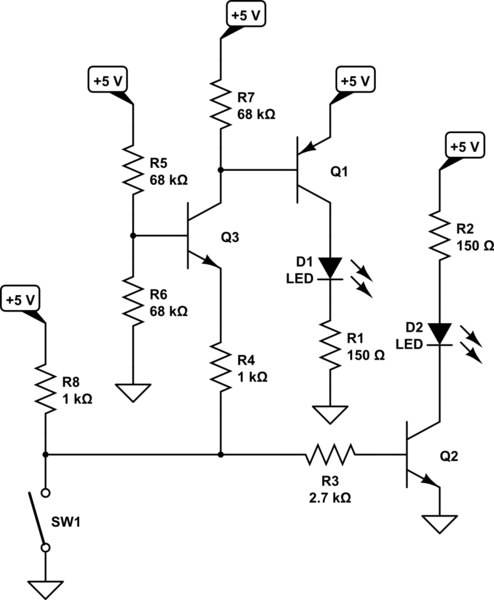I'll just take a very simple approach that starts out with the obvious BJT switches and adds one more BJT in order to complete the circuit. The resulting circuit will consume a little more than either LED requires.
I noticed that you did not mention LED colors. So this obvious approach also works regardless of the color of your LEDs (assuming you stick with the \$5\:\text{V}\$ voltage source.) You can freely adjust the current in either LED, separately.
So let's start:

simulate this circuit – Schematic created using CircuitLab
You can see that these are just polar opposites of each other and that both are supposed to operate as BJT switches. \$R_1\$ and \$R_2\$ can be independently adjusted to provide appropriate current limiting for each LED. The BJT switches will be operated in a way that doesn't require any particular BJT type. I'm estimating \$20\:\text{mA}\$ for each LED.
Of course, the remaining problem is that there are two open (???) connections on the left side of each separate switching circuit (the BJT bases) that need to be "driven" somehow by your grounded single-pole switch (momentary or otherwise.)
To achieve that, another transistor is added. The values for \$R_3\$, \$R_4\$, and \$R_8\$ are calibrated so that the LEDs can achieve up to \$20\:\text{mA}\$ each. So you should hold near those values. The values for \$R_5\$, \$R_6\$, and \$R_7\$ are less critical. I've set them a little towards the higher end of the values you might use to reduce unnecessary wasted dissipation.

simulate this circuit
When the switch is open, \$R_8\$ works together with \$R_3\$ to supply base current for \$Q_2\$, turning it on. Also, \$R_8\$ pulls one end of \$R_4\$ up high enough that \$Q_3\$ is off and therefore allows \$R_7\$ to hold \$Q_1\$ off, as well.
When the switch is closed, the base of \$Q_2\$ is held to ground so it's now off. But the switch pulls one end of \$R_4\$ to ground so that now current is flowing through \$R_4\$, then via the emitter and on to the collector of \$Q_3\$, finally then to supply base current for \$Q_1\$, turning it on. (The purpose here of \$R_5\$ and \$R_6\$ is to provide a modest voltage divider, so that \$Q_3\$ can be either off or on depending on the state of the switch.)
Just a straight-forward approach. How it looks compared to another approach will depend on what's more important to you.









